Fresco boards and tiles with their development history,
Making Fresco Panels
Little Gymnast, 3-18-04
Plywood Board #2 is 3/4 inch, 12x24 with metal lath. First a rough mortar layer on the lath, 1:2, dried. Second, a rough coat with mortar 1:1 lime and sand. Third layer, a thin layer of 1:2 lime with small and medium sand, before this was completely dry, 1.5 hours, I painted a coat of acrylic adhesive/binder on it and toweled on the forth layer. Forth layer, a loose mortar top layer an 1/8 inch thick, 1:1 lime and sifted small crushed limestone.
2:00, panel mortar finished. You have to start somewhere.
3:15, transfered drawing with a ball point pen.
3:45, I started spraying caput mortum on the whole panel, lamp black in the middle and top corner edges, ercolano red in the bottom third and Italian Warm ocher on the bottom quarter.
4:45, finished spraying.
7:45, finished fresco Little Gymnast. Titanium White mixed with lime paste was the last color down. Look at the top heel, see that it is lighter. It's lighter because I painted white down first over the dark background. I want to do this fresco over and build up the flesh with white highlights, like on a black board, then add the flesh colors. Also, I want to mix a batch of tinted color with lime paste in it for the body suit. Then I can spend a lot of time in the flesh areas and paint the body suit last. I really messed up on the flesh color. 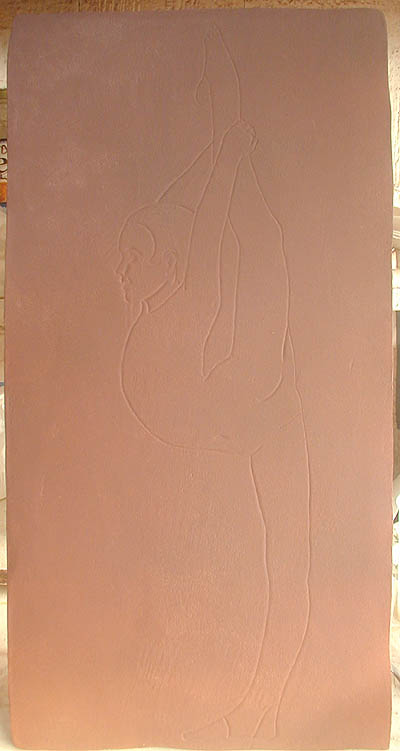
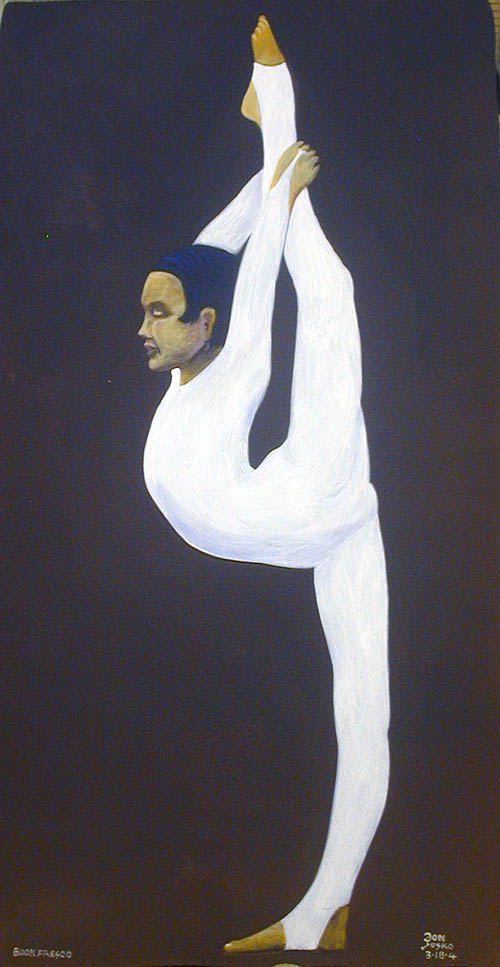
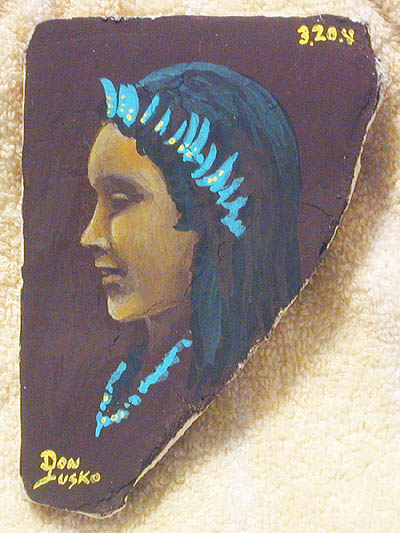
TIP: When you use just lime water and pigment, soap will clean the brushes. When you use lime milk or paste in your pigments, use vinegar to clean the brushes, than soap and water.
Little Bella was the first 12x24 inch fresco on a 3/4 inch board with metal lath. It never cracked.
MUCH LATER I DECIDED IT WAS NOT PRUDENT TO USE THE ACRYLIC BINDER IN THE MORTAR.
Flowers, Apple and Orange 3-19-04
3-19-04, 12:45, Tile #2, 12x12, Wet the tile, paint on skim milk on top of the first coat of mortar (I forgot to scrub it, if it cracks, that's the reason), 1:1 lime, crushed limestone, less then 1/8 inch thick. 1/4 teaspoon of alum added.
2:15, start background.
4:00, Painting lime white on all but the background, to sharpen the outlines on the fruits and flowers, lime paste will also be added to all colors in this fresco.
6:30, Finished. 4:15 painting time. It's still absorbing vary fast. 8:00 still absorbing immediately. 9:00 very slow, it's over, probably a half hour ago. That's about 6 hours of painting time
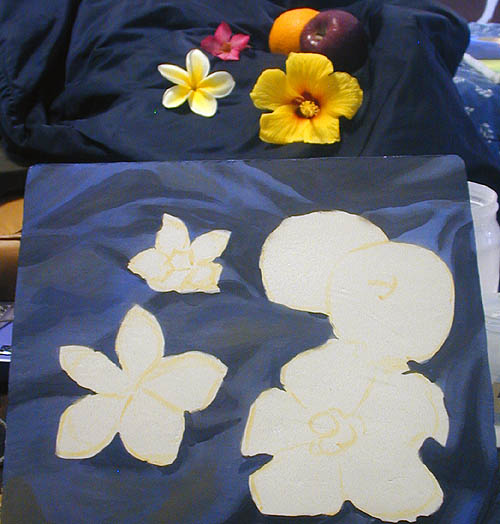
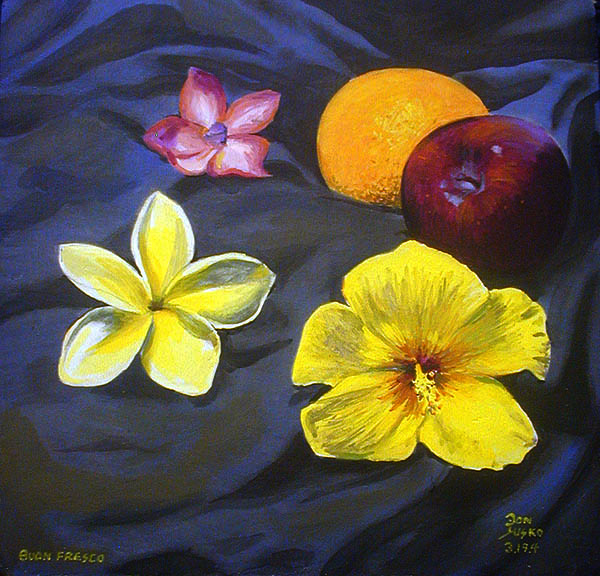
3-19-04, 12:45, Tile #2, 12x12, Wet the tile, paint on skim milk on top of the first coat of mortar (I forgot to scrub it, if it cracks, that's the reason), 1:1 lime, crushed limestone, less then 1/8 inch thick. 1/4 teaspoon of alum added.
TIP: To test if your fresco is still absorbing, apply clean lime water. The optimum best absorption is immediate. It only lasts a short time and shortly afterwards it's over.
Painted Plumerias and Bananas
Board M, 02-29-04 M= 12x12, glue on board mortar applied into wet glue, glue in mortar, small sand and unsifted marble, 1:2.
Board M, 3-20-04. Scrubbed it down, painted on skim milk and put a 1/8 inch intonaco of crushed limestone and lime, 1:1, 1:15 PM.
4:00 start painting.
8:30 finished All the light colors have lime paste added.

Border Design
Tile #9, small half and Board M, 12x12.
Intonaco's finished 3:30 PM, 3-21-4
6:00 PM, start Border Fresco, finish 7:00 PM.
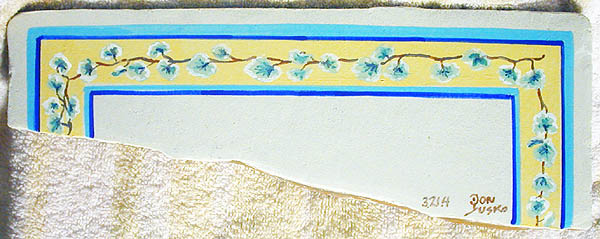
Flowers #1
7:00 start Board G.
The carbonate crust starts forming as soon as the intonaco layer is finished being laid. It slows down the drying process. That's why I was able to start painting at 7:00 and still have the intonaco in an early stage. It might even have made the setting time prolong itself. A young crust breaks down during the first stroke. This is a great step forward for me. That along with Steve's suggestion the my rough coat may have been uneven and causing my intonaco to be more then 1/8 inch in places and cracking. I took all my pre-made boards and sanded the flat on a smooth concrete sidewalk and put a new smooth flat rough coat. I'll still give them a light scrubbing and paint a coat of skim milk on them before adding the intonaco layer. I have to stop this cracking problem.
8:30, it's not 100% covered yet, this is a busy painting. I think I have until at least 11:00. That's 4 hours painting time. I'm using by #9 Series 7, that's a fair sized brush. The yellow in this painting is Indian yellow, the blues are from thalo blue, the magentas are alizarin crimson and quinacridone magenta. I also used quinacridone red, viridian and green oxide and a couple touches of cadmium orange. Not that I had to, I could have done it with 3 colors.
9:30 100% coverage, cutting it close.. 100% coverage is only half way finished.
11:30, Finished, It takes 15 seconds to absorb a big swatch of limewater. That's exceptable! Four and a half hours of painting time.
I'm the only one in Hawaii that is doing this as of now. I don't show my work because I think juried shows are ridiculous. The judges usually can't paint well and most still except Picasso as being a good artist.
This was painted using the Real Color Wheel which uses complements to make darks instead of black pigments, schools are still teaching the incorrect color wheel, it's in their school standards. I hope we get out of these dark ages in my lifetime.

Self Portrait, Age 63
Board #I, 02-29-04 I= 9x12.75, glue on board, glue in mortar, large marble and medium sand, 1:2. Later I found acrylic glue adhesive/bonder is not needed. New rough, READY for intonaco.
Intonaco 3-22-4, 6:15. On top of the rough I painted an acrylic bonding agent and laid the intonaco, 1:1 lime and crushed limestone. PAINTING SELF PORTRAIT.
Start 8:45, the mortar is still soft, I have to be very light with the brush. The colors are not absorbing yet but that's good for changing the initial drawing. The light is florescent, the colors I chose are: raw siena, Italian warm ocher, Cinabrese, Ercolano red, Thioindigoid red, Quinacridone magenta, Raw umber, cobalt blue light, thalo blue, titanium white. I shaped my beard, combed my hair, and I have to remember to smile.
10:00 The mortar is still soft, the paint is just starting to absorb but can still be lightly moved.
10:20. the first signs of a crust is showing up, from here on I will have to be making full color strokes, but they are not holding well yet.
11:30, Blends are still hard to make, but I'm getting down big color. Strokes just won't hold yet.
11:50, strokes are starting to hold but still leaving puddles at the end of them. They each have to be blended out.
12:20, It's happening, strokes are staying put. If my estimate is right, I've got two hours of great painting time left.
2:15, Finished. It's still absorbing after 5.5 hours of painting time. The mortar is soft enough to smooth out the sides.
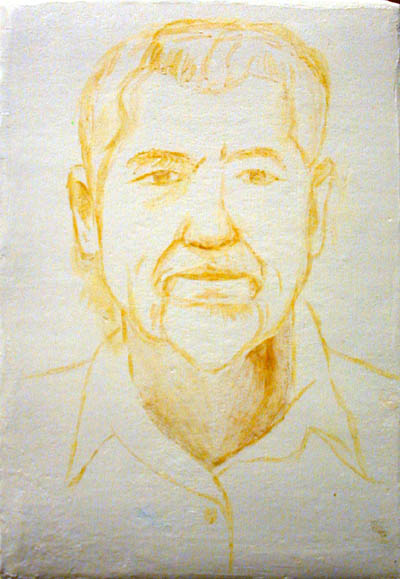

Board H, 02-13-04 H= 9x12, glue on board, glue in mortar, large marble and medium sand, 1:2.
3-24-4, Today I added another layer of rough coat, first I scrubbed the first coat and painted a weak coat of casein. Second coat of rough = 1 lime, 1 fine limestone, 1 medium sand, no bonder added.
3-24-4, Intonaco, 1:1 lime and small crushed limestone, from pre-made batch for Boards, no water added, less the 1/8th inch thick.
2:50 PM. SELF PORTRAIT #2, 3-24-4
5:00 start, coat of limewater, every 10 minutes, I have a cooking timer.
6:15, Using new flat Raphael brushes, series #905, #8, Nothing smears when I add limewater every 10 minutes, but everything soaks in deeper and gets lighter.
8:10, I'm very happy with this new technique, 8:45, The fast absorption has been continuos for ever. I feel it can go on for a long time. I have already gone trough more limewater then all my other frescos combined, I think.
9:30, I got my first smear while wetting down. Maybe it was because I had just put down some very dark colors. I'm taking a 10 minute break and wet it down again. It's still absorbing quickly but I think I have to stop wetting down and just paint. All my work is just sinking in. I shot a picture and wet it down again, yes color is sinking in too much. Those light lines on the right side of my face are from uneven pressure with the trowel.

It lasted for 8 hours or more doing it this way but what is the use? I have the painting pretty well laid out, from here until the end I am just going to paint, and most every thing will have to be painted again. Every color from here out will be more opaque, lighter colors will have lime paste added to the titanium white.
11:00, it's still absorbing beautifully, I have no doubt there are hours of painting still left in this fresco. As of now I am still loading the brush with opaque pigments. The areas are getting smaller but I know I could be working on four square feet with no problem using bigger brushes.
12:25 AM, Finished, the last color down was the whole background. The colors I used were: Naples yellow, titanium white, light gold ocher, Italian warm ocher, ercolano red, cobalt blue light, Thalo blue, caput mortum and verdaccio. My darkest color was Thalo blue and Thioindigoid red combined. Seven and a half hours of painting, I'm sure I could have gone to eight hours and more if I kept wetting it down. Buon Fresco.

3:15 AM, after cleaning up I noticed I forgot to put in the shadow on my shirt. It absorbed immediately. That's 10 hours of buon fresco painting.
9:00 AM, I think I went overboard.. The next morning I could see it was still absorbing, I could still add colors, and they absorbed fast, lime paste shows it's true color within 3 minutes. It was also becoming splotchy, which I could still fix. I have put too much water in the setting mortar. It probably won't crack, that problem was fixed 3 days ago when I learned to make my rough very flat and use 3/32" of intonaco and no more, 4/32"=1/8".
I really don't know yet exactly how much limewater will bring absorption up to eight hours even. I had put on 20 washes in 4 hours. My next fresco will get a lime wash every half hour and wait, with out painting, 4-5 minutes before applying it. There is a formula here someplace, I get 5 hours painting time without adding limewater. I liked that I started painting 2 hours after laying the intonaco, it accepted paint right away without making puddles on each stroke.

|













